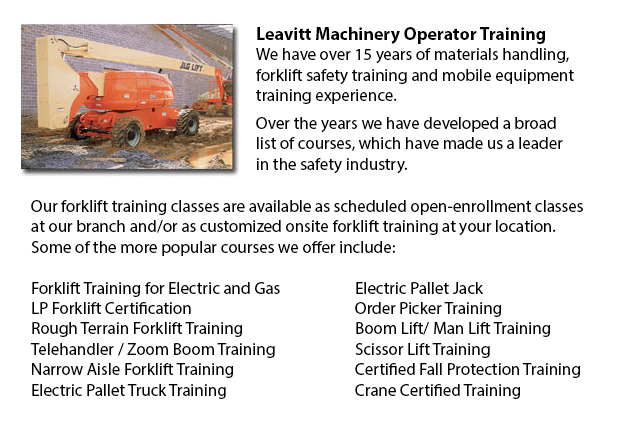
Aerial Lift Safety Training Marysville - There are approximately 26 to 30 construction fatalities within North America due to the utilization of aerial lifts. Nearly all of the individuals killed are craftsmen like for instance laborers, painters, electrical workers, carpenters or ironworkers. The majority of the fatalities are caused by tip-overs, electrocutions and falls. The greatest danger is from boom-supported lifts, like for instance cherry pickers and bucket trucks. Nearly all deaths are related to this kind of lift, with the rest involving scissor lifts. Other dangers comprise being struck by falling things, being thrown out of a bucket, and being caught between the lift bucket or guardrail and an object, like a joist or steel beam.
The safe operation of an aerial lift needs an inspection on the following items prior to utilizing the device: emergency and operating controls, personal fall protection gear, safety devices, and wheels and tires. Inspect for possible leaks in the air, hydraulic fluid and fuel-system. Check the device for loose or missing parts.
The areas that worker will make use of the aerial device must be checked thoroughly for potential dangers, like for instance holes, bumps, debris and drop-offs. Overhead powerlines have to be monitored and avoided. It is recommended that aerial lift devices be used on surfaces that are level and stable. Do not work on steep slopes that exceed slope restrictions specified by the manufacturer. Even on a slope which is level, wheel chocks, outriggers and brakes must be set.
Employers are required to provide maintenance mechanics and aerial lift operators with the proper guidebooks. Mechanics and operators must be trained by a certified individual experienced with the relevant aerial lift model.
Aerial Lift Safety Tips:
o Before operating, close lift platform chains and doors.
o Do not lean over or climb on guardrails. Stand on the floor of the bucket or platform.
o Stay within manufacturer's load-capacity restrictions.
o When working near traffic, make use of correct work-zone warnings, like for example cones and signs.
If right procedures are followed, electrocutions are avoidable. Stay at least ten feet away from whichever power lines and certified electricians must insulate and/or de-energize power lines. People working must utilize personal protective tools and equipment, like for instance a bucket which is insulated. Then again, a bucket which is insulated does not protect from electrocution if, for instance, the person working touches another wire providing a path to the ground.
Falls are preventable if the individual working remains secure inside guardrails or in the bucket by making use of a full-body harness or a positioning device. If there is an anchorage in the bucket, a positioning belt with a short lanyard is adequate.
By following the manufacturer's instructions, tip-overs can be prevented. Never drive the lift platform while it is elevated, unless the manufacturer specifies otherwise. Follow the device's vertical and horizontal reach limits, and never go beyond the specified load-capacity.
-
Manlift Safety Training Marysville
Manlift Safety Training Marysville - It is important for experienced Manlift operators to be aware of the connected hazards which come with particular types of scissor lifts. They must be able to operate the scissor lift in a way that protects not on... More -
Forklift Operator Certification Marysville
Forklift Operator Certification Marysville - Forklift operator certification is normally required for employees working in industrial, warehouse or construction environments to guarantee the safe utilization of forklifts. Workplace training need to f... More -
Crane Training School Marysville
Crane Training School Marysville - The crane training school offers industry-relevant programs. Courses provide trainees with learning outcomes that match present industry demands. Our small class sizes combine hands-on experience and theory. Our ind... More -
Heavy Equipment Training Marysville
Heavy Equipment Training Marysville - Normally, the different kinds of heavy equipment training are divided into 2 categories of machines: those that have rubber tires and tracked vehicles. Tracked vehicles comprise items like cranes, bulldozers and... More -
Counterbalance Forklift License Marysville
Counterbalance Forklift License Marysville - Forklifts, when operated by fully trained workers, are a major advantage to companies. We provide a thorough training program covering all aspects of operating a powered lift device. Counterbalance forklif... More -
Boom Lift Safety Training Marysville
Boom Lift Safey Training Marysville - Boom lifts are a type of elevated work platform or aerial lifting device which are normally utilized in warehousing, construction and industry. Boom lifts could be used in virtually any environment due to their v... More -
Aerial Lift Training Marysville
Aerial Lift Training Marysville - An aerial work platform is a mechanical access platform. This particular machinery provides access to otherwise not accessible areas for equipment or people. Likewise called an elevating work platform or aerial devic... More -
Aerial Boom Lift Training Marysville
Aerial Boom Lift Training Marysville - For people who operate or supervise the utilization of aerial lift platforms, right aerial boom lift Training is necessary. The aerial lift platform is for lifting people, materials and tools to elevated work lo... More

Forklift Training Marysville
TOLL FREE: 1-888-254-6157
Marysville, Washington
forklifttrainingmarysville.com
Email Us
About Us


